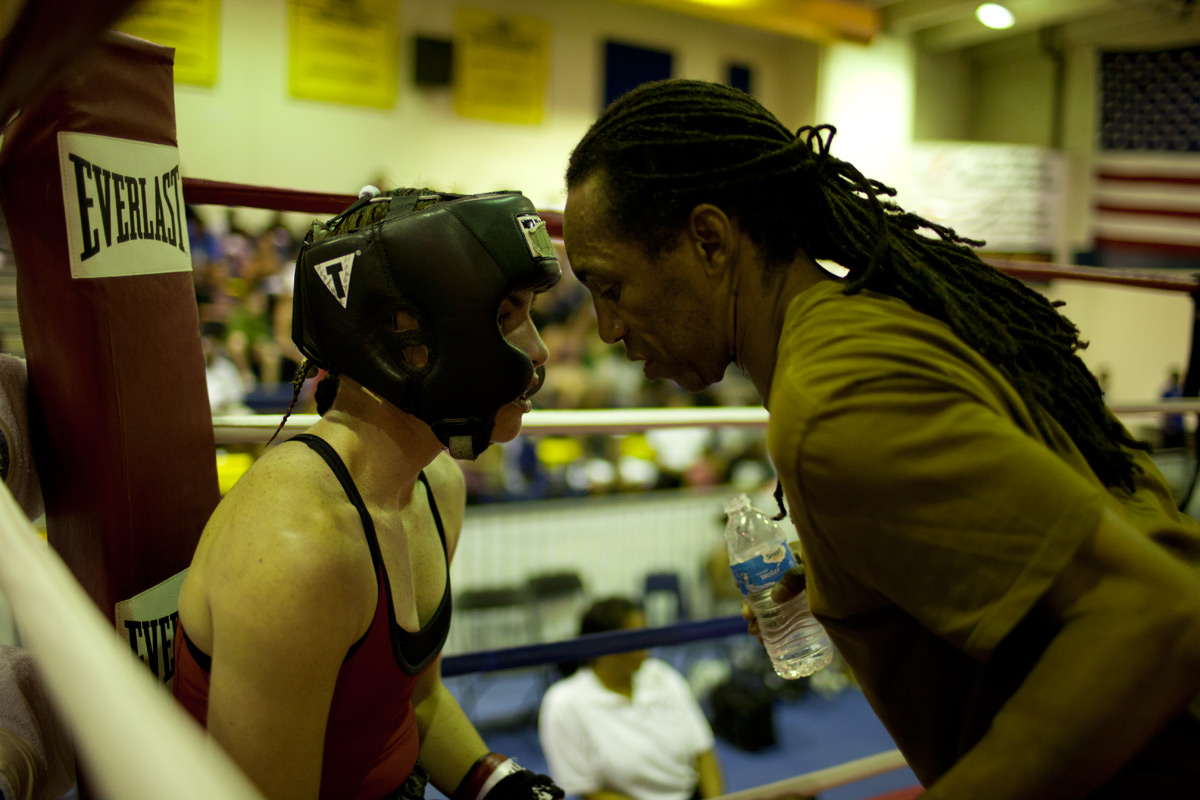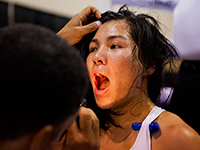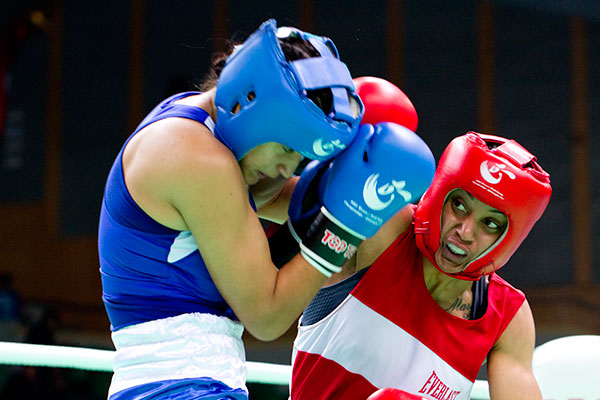This summer women will make sports history by boxing for the first time in the Olympic Games. But stepping into the ring means risking brain injury and, in rare cases, sudden death.
(Listen to WNYC's special following the boxers who competed to make the first US Olympic women's boxing team, Go For It: Life Lessons from Girl Boxers)
In Olympic boxing, fighters wear headgear. When a boxer gets hit, there’s foam and leather between her opponent’s glove and her skull. But that doesn’t mean a punch feels like a pat.
“You ever see in the cartoons when the stars go around?” asked Heather Hardy after a sparring session at Gleason’s gym in Brooklyn. “It really feels like that! Your head is vibrating, you hear this ‘ahhh’ sound.”
Hardy, a 30-year old single mother, said she thoroughly understands the risks of a blow to the head. “I know it’s dangerous, I work at Gleason’s!” she said. “I see these punchy boxers come in all day – can’t talk, their speech is slurred. And it’s not because anything other than they’ve been hit in the head too much.”
But many boxers have never done the risk benefit analysis Hardy says she’s thought through. Before 17-year old Claressa Shields made it onto the first-ever US Olympic women’s boxing team, she spoke with host Rosie Perez at an event with WNYC and The Jerome L. Greene Space. When Perez brought up the risk of brain damage and asked Shields if she had ever been knocked out, Shields responded, “No, and I haven’t ever thought about the long term effects.”
(Photo: Heather Hardy has her pro debut in August. Her coach tells her constantly to protect her head./Sue Jaye Johnson)
Traumatic Brain Injury
In recent years, research on the brains of people who play rough sports—like boxing, hockey, football and even soccer—has raised two primary concerns. First, a blow to the head can kill you—especially if you’re still recovering from a previous hit. Second, if you get hit in the head over and over again – even when no single blow knocks you out (or, as they say, “rings your bell”) — it can lead to a long list of serious problems later on, including depression, slurred speech, memory loss and Parkinson’s disease.
“Concussion implies yes or no, you either have it or you don’t,” said Charles Bernick, a researcher with the Cleveland Clinic’s Lou Ruvo Center for Brain Health. “Traumatic brain injury isn’t like that.
Last year, Bernick and his colleagues started enrolling boxers and mixed martial arts fighters in a long-term study of their brains and behavior. Preliminary results are striking: after just six years of fighting, researchers have seen physical changes in the fighters’ brains and after 12 years, the fighters demonstrate cognitive symptoms.
“The more fights they had, the worse their self control,” Bernick explained, “the worse they preformed on tests with memory.” It also took them longer to get through the tests.
“So it suggests there may be damage or structural changes occurring years before somebody becomes symptomatic,” Bernick said. “We should really be monitoring these athletes a little sooner than later.”
Bernick said preliminary findings do reveal a possible difference between the men and women in his study. In women, researchers have seen the same structural changes in the brain after six years of fighting, but after 12 years, there they have not been seeing the same cognitive symptoms. Bernick said he doesn’t have enough data to draw conclusions from such early results—there are only about ten women in the study so far, too few to be a representative sample. But he guessed one explanation could be that women fighters aren’t getting hit as often or as hard.
Some studies have suggested that the protective headgear amateurs wear reduces the risk of brain damage. But nothing can protect you completely.
Boxers Want To Box
At the U.S. Olympic Team Trials in Spokane, WA, ringside doctor Martha Dobson put it plainly, “What’s at stake is sudden death, vegetative state, comatose state.”

At tournaments, amateur boxers see a doctor each morning before they fight to make sure they're healthy enough to step into the ring. But sometimes boxers will lie about injuries or symptoms to make sure they get a chance to compete.
At the Olympic team trials in Spokane, middleweight boxer Dara Shen of Alexandria, VA, was among those competing for a chance to go to London. But after her first fight of the tournament, she got a bad headache.
(Photo: Dara Shen, middleweight from Alexandria, VA, with a ringside doctor after a bout at the Police Athletic League Tournament in Ohio/Sue Jaye Johnson)
“I had a hard time sleeping,” she said, “and the next morning the doctor asked me if I had a headache and initially I wanted to say no because I wanted to fight.”
Dr. Dobson said Shen “cut her eyes away” when she answered the question. Shen said she hesitated, reviewing in her mind the ramifications of each answer.
“I was playing back how hard it was for me to sleep and my neck stiff as hell and my brain literally throbbing,” she said. But she was also thinking, “Oh my god I’m here! This is the Olympic trials! It’s a chance of a lifetime.”
Shen admitted to a headache. Dobson did some more tests and gave her a medical DQ, disqualifying her from the tournament and the chance to go the Olympics.
“Another injury on top of that bruise could be catastrophic,” she said. “And it doesn’t have to be a significant blow.”

Queen Underwood, in red, is Team USA's lightweight at the London Olympics. (Sue Jaye Johnson)
Second Impact Syndrome
Sometimes boxers don’t know they have an injury. Last year at the National Championships, a Florida boxer named Ishika Lay fell into a coma after a blow to the head. And seven years ago, a Becky Zerlentes went unconscious at a Golden Gloves tournament in Colorado and died the next day.
“It was a blur,” said her husband Stephan Weiler, an economics professor at Colorado State University. Weiler said he and his wife were a great match because they were so different—he was the planner, she was spontaneous. She boxed, he called boxing “Neanderthal.” But he said he believes in the equality of opportunity. Talking about the loss of his wife over the phone from Colorado, Weiler said, “You know men can do something, women should be able to do it to. I just wish it didn’t have to be in boxing. And I mean that for both men and women.”
After Becky Zerlentes autopsy in 2005, Weiler said doctors told him the cause was likely Second Impact Syndrome, a blow to the head while a person is still recovering from an initial brain injury.
Looking back, Weiler said, he would never have told his wife not to box, despite his misgivings. “It was a partnership, it was a marriage, it was a friendship. Part of that is accepting people for the whole individuals they are. And that was part of her.” But he said he hopes, by telling her story, he’ll encourage people to think. “People need to make up their own minds,” he said, “but they need to make up their own minds understanding what some of the risks are.”
Why risk death or dementia to fight?
Many boxers and boxing fans have a long list of reasons for risking their lives to stay in the ring. Vanessa Chakour, a New York-based trainer and former boxer, sees the sport, in part, as a tool for recovery and self-understanding. After a series of troubles as a kid that included anorexia and a car crash that left her in a body cast for a year, Chakour said, she was hungry to push herself to her limits.
“I loved exploring what was holding me back,” she said. “I loved exploring my vulnerabilities, my weaknesses. I loved discovering strength I didn’t even know I had.”
Boxing tests your strength and spirit like few other sports can, in Chakour’s view. “You can’t say, ‘I’m kind of tired now I’m going to step out and have somebody replace me.’ You can’t do that. It’s only you and your opponent and that’s it.”
Chakour agrees with critics that, especially as a business, boxing can be dangerous and scary. “People do want to see brawls,” she said.
“But there’s boxing matches that are absolutely graceful,” she countered, “people who have such a heightened sense of intuition or awareness that nothing touches them.”
In London next month, three American women will face the best female boxers of the world, 36 in total, despite all the risks entailed.
